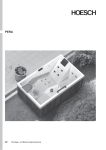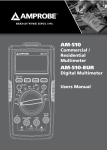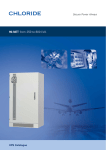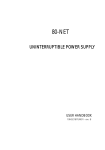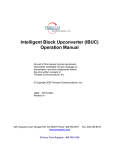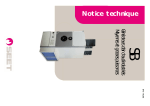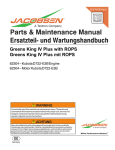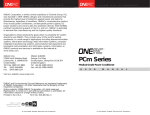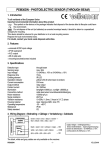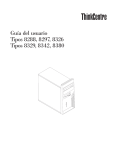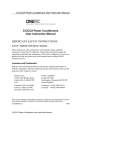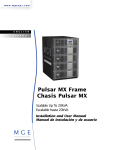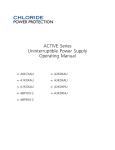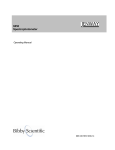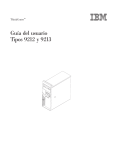Download ONePlus Series Power Condition Series Brief in PDF
Transcript
ONePlus UPS ONePlus Series UPS User Instruction Manual IMPORTANT SAFETY INSTRUCTIONS SAVE THESE INSTRUCTIONS. Please read and save these instructions. This manual contains important instructions for the ONePlus UPS. Follow these instructions during the unpacking, installation and maintenance of the ONePlus UPS. If you have a problem with the unit, please refer to this manual before calling ONEAC Technical Services. Licenses and Trademarks ONEAC, Virtual Kelvin Ground and MopUPS are all registered trademarks and ONePlus is a trademark of ONEAC Corporation. All other trademarks, product and corporate names are the property of their respective owners. ONEAC USA 27944 North Bradley Road Libertyville, IL 60048-9700 USA ONEAC EUROPE George Curl Way Southampton, Hampshire SO18 2RY United Kingdom Telephone: (847) 816-6000 Toll Free: (800) 327-8801 Facsimile: (847) 680-5124 Telephone: +44 (0) 2380 610311 Facsimile: +44 (0) 2380 612039 Entire contents copyright © 2004 ONEAC Corporation. All rights reserved. Reproduction in whole or in part without permission is prohibited. All information subject to change without notice. 913-577 Rev. - ONePlus UPS User Instruction Manual 12/04 Introduction ....................................................................................... 1 Registering Your ONEAC UPS ............................................................. 1 Technical Support ............................................................................... 1 FCC Compliance ................................................................................ 2 Safety (English) ................................................................................... 3 Sicherheitshinweise (Deutsch) ............................................................. 4 Mesures de sécurité (Français) ............................................................ 5 Seguridad (Español) ............................................................................ 6 Theory of Operation ........................................................................... 7 AC Power Mode .......................................................................... 7 Battery Backup Mode ................................................................... 7 Output Overload Protection ......................................................... 8 Setup and Installation ......................................................................... 9 Installation ................................................................................... 9 Long Term Storage ...................................................................... 9 Ventilation ................................................................................. 10 Grounding the Unit .................................................................... 10 Connections .............................................................................. 11 ONePlus Front Panel ................................................................... 12 Power Switch ............................................................................. 13 Self-Test ..................................................................................... 14 Indicators and Alarms ................................................................ 14 Communications ........................................................................ 16 Features and Specifications ............................................................... 19 Physical and Electrical Specifications ........................................... 20 Specifications and Characteristics ............................................... 21 Typical Runtimes ........................................................................ 23 Battery Considerations ..................................................................... 23 Battery Replacement Procedures ................................................ 24 Testing New Batteries ................................................................ 25 Battery Disposal ......................................................................... 26 UPS Disposal .................................................................................... 26 Troubleshooting ............................................................................... 27 Warranty .......................................................................................... 30 Batteries .................................................................................... 30 Limitations of Warranty .............................................................. 30 Exclusive Remedies ..................................................................... 30 Return Procedure ....................................................................... 30 ONePlus UPS User Instruction Manual i Introduction Introduction Thank you for selecting this uninterruptible power supply (UPS). ONEAC’s ONePlus UPS offers the most reliable protection from the harmful effects of electrical line disturbances for your computing and communications equipment. ONEAC’s ISO 9001 certification represents our commitment to building world-class products. We take pride in every unit that leaves our manufacturing facility. RegisteringYour ONEAC UPS To ensure that your ONePlus Series UPS model and serial number are registered, complete and mail the enclosed postage-paid warranty card or go on line at www.oneac.com. Technical Support ONEAC offers 24-hour technical support. To contact ONEAC Technical Services: • North America: (847) 816-6000, option 3 or toll free (800) 327-8801, option 3. • Europe: +44 (0) 1235 861962 • email: [email protected]. In North America, all calls received before 7 a.m. and after 5 p.m. CST are forwarded to a cell phone. Between 5 p.m. and 10 p.m. CST, ONEAC Technical Services Representatives will return your call within one half hour (between 5 p.m. and 10 p.m.). Except for emergencies, calls received between 10 p.m. and 7 a.m. CST will be returned during normal business hours. Please check with ONEAC Technical Services before attempting to repair or return any ONEAC product. If an ONEAC UPS needs repair or replacement, ONEAC Technical Services will issue a Return Material Authorization (RMA) number along with instructions on how to return the UPS. ONePlus UPS User Instruction Manual 1 FCC Compliance FCC Compliance ATTENTION: Changes or modifications to this unit not expressly approved by the party responsible or in FCC compliance could void the user’s authority to operate the equipment. This equipment was tested and complies with the limits for a Class A digital device, pursuant to Part 15 of FCC Rules. These limits are designed to provide reasonable protection against harmful interference when the UPS is operating in a commercial environment. The UPS generates, uses, and can radiate radio frequency energy. If installation and use is not in accordance with the instruction manual, it may cause harmful interference to radio communications. ATTENTION: Operation of this equipment in a residential area may cause harmful radio communications interference. The user is responsible for correcting the interference. 2 ONePlus UPS User Instruction Manual Safety Safety (English) WARNING: This equipment services power from more than one source. The output receptacles may have voltage even when the unit is unplugged. UPSs present a different safety issue than most electrical equipment because unplugging the UPS puts it into backup mode. Unplugging the UPS does not remove the electrical charge. To ensure that the UPS is off, turn the power switch OFF before unplugging the UPS from the wall outlet. CAUTION: Operating this equipment without proper grounding may present a risk of electrical shock. Do not use AC adaptors with only two conductors to connect the input line cord to the wall socket as this will not connect the earth ground to the equipment. WARNING: Dangerous voltages are present within this unit! There are no user-serviceable parts inside. Any repairs or modifications by the user may result in out-of-warranty repair charges, unsafe electrical conditions, or violation of electrical code. Do not remove the cover. All repairs should be done by qualified service personnel. Voltages inside the UPS may be lethal. Internal components are powered even when the UPS is turned OFF. Even with the battery disconnected and the unit unplugged, energy is stored in high voltage capacitors and represents a severe shock hazard. ONePlus UPS User Instruction Manual 3 Sicherheitshinweise Sicherheitshinweise (Deutsch) ACHTUNG:Dieses Gerät erhält seinen Strom von mehr als einer Quelle. Die Ausgangssteckdosen führen unter Umständen Spannung, selbst wenn der Stecker des Gerätes ausgesteckt wurde. Für USVs müssen andere Sicherheitsmaßnahmen als für die meisten Elektrogeräte ergriffen werden, da die USV durch Ausstecken in den Reservebetrieb gebracht wird. Wenn der Stecker der USV abgezogen wird, wird die elektrische Ladung hierdurch nicht entfernt. Um sicherzustellen, daß die USV ausgeschaltet ist, muß der Netzschalter auf AUS (OFF) gestellt werden, bevor der Stecker der USV aus der Wandsteckdose gezogen wird. VORSICHT: Durch Betreiben dieses Gerätes ohne ordnungsgemäße Erdung können Elektroschocks riskiert werden. Keine Wechselstromadapter mit nur zwei Stromleitern verwenden, um das Netzkabel an die Wandsteckdose anzuschließen, weil das Gerät hierdurch nicht an die Erde angeschlossen wird. ACHTUNG:In diesem Gerät sind gefährliche Spannungen vorhanden! Im Inneren dieses Gerätes befinden sich keine vom Benutzer zu wartenden Teile. Durch etwaige Reparaturen oder Modifikationen durch den Benutzer können nicht von der Garantie gedeckte Reparaturkosten, gefährliche elektrische Zustände oder Verstöße gegen Stromvorschriften entstehen. Abdeckung nicht entfernen. Alle Reparaturen sollten von qualifizierten Wartungstechnikern durchgeführt werden. Die Spannungen im Inneren der USV können tödliche Verletzungen zur Folge haben. Die internen Komponenten führen Strom, selbst wenn der Stromschalter auf AUS (OFF) steht. Auch wenn die Batterie nicht angeschlossen und der Stecker des Gerätes ausgesteckt ist, wird Energie in Hochspannungskondensatoren gespeichert, und dies bedeutet eine ernsthafte Elektroschockgefahr. 4 ONePlus UPS User Instruction Manual Mesures de sécurité Mesures de sécurité (Français) AVERTISSEMENT : Cet équipement est alimenté par plus d'une source. Des tensions peuvent être présentes aux prises de sortie, même lorsque l'unité est débranchée. Le problème de sécurité sur l'UPS diffère de celui de la plupart des équipements électriques, car lorsqu'il est débranché, il se met en mode de réserve. Son débranchement n'élimine pas la charge électrique. Pour s'assurer que l'UPS est hors tension, mettre l'interrupteur d'alimentation sur ARRÊT (OFF) avant de débrancher l'UPS de la prise murale. ATTENTION : Si cet équipement fonctionne sans être correctement mis à la terre, un risque de choc électrique peut en résulter. Ne pas utiliser d'adaptateurs CA n'ayant que deux conducteurs pour brancher le cordon d'alimentation dans la prise murale, car l'équipement ne serait pas mis à la terre. AVERTISSEMENT : Cet équipement renferme des tensions dangereuses! Il ne contient aucune pièce réparable par l'usager. Toutes réparations ou modifications effectuées par l'usager peuvent entraîner des frais de réparation non couverts par la garantie, un danger électrique ou l'infraction à un code électrique. Ne pas enlever le couvercle. Confier toutes les réparations à un personnel d'entretien qualifié. Les tensions présentes dans l'UPS peuvent être mortelles. Les composants internes de l'unité sont sous tension, même lorsque l'interrupteur d'alimentation est sur ARRÊT (OFF). Même lorsque la batterie est déconnectée et l'unité débranchée, de l'énergie est stockée dans des condensateurs à haute tension et représente un grave risque d'électrocution. ONePlus UPS User Instruction Manual 5 Seguridad Seguridad (Español) ADVERTENCIA: Este equipo suministra alimentación desde más de una fuente. Los tomacorrientes de salida pueden tener voltaje aun cuando la unidad esté desenchufada. Las UPS (fuentes de alimentación ininterrumpibles) cuentan con una característica de seguridad diferente a la mayoría de los equipos eléctricos, ya que al desenchufarse, quedan en el modo de reserva. Al desenchufar una UPS no se elimina la carga eléctrica. Para cerciorarse de que una UPS esté apagada, gire el interruptor de alimentación a la posición APAGADO (OFF) antes de desenchufar el UPS del tomacorriente mural. PRECAUCION: El hacer funcionar este equipo sin la conexión a tierra adecuada representa un riesgo de descargas eléctricas. No utilice adaptadores de CA con sólo dos conductores para conectar el cable de la línea de entrada al enchufe mural debido a que éste no conectará el equipo a tierra. ADVERTENCIA: ¡Esta unidad tiene voltajes peligrosos!. En su interior no hay piezas que pueda reparar el usuario. Las reparaciones o modificaciones hechas por el usuario pueden dar como resultado cargos de reparación no cubiertos por la garantía, y producir situaciones de riesgo eléctrico o violación de los códigos eléctricos. No retire la cubierta. Todas las reparaciones deben ser realizadas por personal de servicio calificado. Los voltajes del interior de las UPS pueden ser mortales. Los componentes internos tienen electricidad aun cuando el interruptor esté en la posición APAGADO (OFF). Incluso si la batería está desconectada y la unidad desenchufada, se almacena energía en capacitores de alto voltaje, lo cual representa un peligro grave de descarga. 6 ONePlus UPS User Instruction Manual Theory of Operation Theory of Operation The ONePlus UPS has two operating modes: Conditioned AC Power and Conditioned Battery Backup. AC Power Mode When utility AC power is present and within the correct voltage range, the UPS provides fully conditioned power: • Electronic equipment is protected from harmful transient voltage spikes and other electrical noise. • UPS detector circuits continuously monitor the utility power for blackout, low voltage, and overvoltage events. The buck and boost feature will compensate for a wide range of voltage variations without depleting the batteries. Battery Backup Mode In an extreme over- or under-voltage situation, the detector circuits determine that utility AC power is no longer in an appropriate voltage range. The UPS switches to battery to supply continuous conditioned power. While in backup mode, detector circuits monitor the return of utility AC power. The UPS synchronizes with the utility’s frequency when utility AC power is available. The equipment is supplied continuously with conditioned power even when running in battery backup mode. ONePlus UPS User Instruction Manual 7 Theory of Operation If the battery becomes exhausted while maintaining the load, battery backup terminates and the UPS output turns off. A low battery warning is sounded and transmitted via the communications port approximately two minutes prior to termination of battery backup. The UPS monitors the line and provides output when utility power is restored to normal operating range. Output ON/OFF Switch Front Panel Display Fig. 1: ONePlus UPS Front View Output Overload Protection During normal operation, electronic output overload protection is active. If the output is loaded to more than 105 percent of the UPS rating, battery power to the UPS is not available. To reset, turn the UPS OFF, remove some of the load, then turn the UPS ON. (For GS compliance: The power distribution system for all models is type TN.) Input Protector A grossly overloaded UPS trips the rear panel circuit breaker. The front panel display reads “c1.” To reset the circuit breaker, push the button in. • If the circuit breaker trips repeatedly following reset, unplug the equipment from the UPS output receptacles and reset the circuit breaker once again. • If operation appears to be normal, check the total equipment load. Add your equipment to the output one device at a time. Check the front panel display after each device is powered ON. 8 ONePlus UPS User Instruction Manual Setup and Installation • If the circuit breaker trips with nothing plugged into the output receptacles, there may be an internal problem with the UPS. Call ONEAC Technical Services for assistance (refer to page 1). Setup and Installation Inspection and Unpacking Installation Before shipment, this product was tested, inspected and found to be free of mechanical and electrical defects. Upon receipt of your UPS, carefully examine the packing containers for any sign of physical damage. Notify the carrier immediately if damage is present. After inspecting, carefully unpack the UPS. Retain the packaging materials for reuse or dispose of the materials properly, see Return Procedure on page 30. Once unpacked, inspect and test the unit for hidden damage that may have occurred in transit. If damage is evident, contact ONEAC Technical Services. When selecting a location for your UPS, be sure that the unit is near a properly wired AC electrical outlet and is easily accessible for all other connections (the loads and/or optional communications cable). Leave at least 2 inches of clearance on each side of the UPS for proper ventilation. CAUTION:Do not cover or install the UPS in a confined or enclosed space. Choose an area that is clean and dust-free. If the environment is dusty, clean the outside of the unit with a vacuum cleaner. For optimal battery life, keep the UPS at an ambient temperature of 25°C (77°F). Long Term Storage Improper long-term UPS storage may damage the UPS battery and invalidate the battery warranty. Unplugging a UPS from its AC utility power source for an extended period of time results in lost battery charge. Restoration of charge to maximum capacity requires 24 - 48 hours. ONePlus UPS User Instruction Manual 9 Setup and Installation To keep the battery enclosure fully charged and to maximize the life of the battery, plug the UPS into an outlet while it is in storage. If the UPS is stored without power access, plug it into a power source for 24 hours at least once every 4 - 6 months. ATTENTION: If the storage temperature is greater than 30°C (86°F) plug the UPS into a power source for 24 hours every 2 to 3 months. ATTENTION: The UPS should not be stored at temperatures below -15°C (+5° F). Ventilation The ventilation requirement for ONePlus is a minimum of 2 inches (50 mm) of clearance on all sides. Grounding the Unit To eliminate shock hazard, connect the unit to a properly grounded AC receptacle. Before applying power, verify that the available line voltage matches the voltage listed on the rear-panel label. CAUTION: Interruption of the protective grounding conductor or disconnection of the protective earth terminal presents a potential shock hazard that could result in personal injury and damage to the equipment. NOTE: When connecting the UPS, make sure that the receptacle has power available and is not controlled by a wall switch. 10 ONePlus UPS User Instruction Manual Setup and Installation Connections Before beginning, shut down and unplug the equipment to be protected. DO NOT make any connections or attempt to use any of the equipment until all the following connection instructions have been reviewed and completed. Site Wiring Fault Indicator Serial Communication Port USB Communication Port Input Circuit Breaker Four 5-15 Receptacles Ground Lug fig. 2: 250 and 400 VA ONePlus UPS Back Panels Serial Communication Port USB Communication Port Site Wiring Fault Indicator Serial Communication Port USB Communication Port Site Wiring Site Wiring Fault Indicator Fault Indicator Eight 5-20 (for 5-15R or 5-20Rs) Ground Lug Six 5-15 Receptacles Input Circuit Breaker Ground Lug Input Circuit Breaker 600 VA ONePlus 1000 VA ONePlus fig. 3: 600 and 1000 VA ONePlus UPS Back Panels Connect communication cable from Terminal to UPS (optional) fig. 4: Typical UPS Installation ONePlus UPS User Instruction Manual 11 Setup and Installation 1. Plug the ONePlus UPS into a properly wired AC electrical outlet. 2. Plug the equipment to be protected into the UPS. CAUTION: Do not attach laser printers to the UPS. A laser printer periodically draws significantly more power during use and may overload the UPS. 3. Press the power switch ( ) on the front panel of the UPS for 2 seconds to turn the unit ON. The ONePlus performs a self-test when it is first plugged in and turned on. After the self-test the unit enters Normal-mode. If the alarm sounds or the UPS alarm indicator stays on, see Table 4, “System Code Status Chart,” on page 27. NOTE:The batteries charge to 90% capacity in approximately 3 to 6 hours. However, it is recommended that the batteries charge for 6 - 24 hours after installation or after long-term storage. If long term storage is necessary, the batteries should be charged every 6 months by plugging the UPS into a power outlet for 24 hours. ONePlus Front Panel 12 The ONePlus front panel lights indicate status of the unit and potential power problems. For alarm codes ONePlus UPS User Instruction Manual Setup and Installation and indicators, see System Code Status Chart on page 27. Power Switch Audible Alarm/Load Power Battery Fault Temperature 250-400 VA ONePlus UPS Front Panel Power Battery Fault Temperature Power Switch Audible Alarm/Load 600-1000 VA ONePlus1 fig. 5: ONePlus UPS Front Panel Power Switch With the UPS connected to a properly wired AC input power source, press the power switch ( ) on the front panel for 2 seconds. Power is supplied to the output connectors. Turn OFF the UPS by pressing the power switch ( ) for 2 seconds. This turns the power to the output connectors “OFF.” The internal charger will continue to charge and maintain the battery as long as the line cord is connected to a live input AC power source. ONePlus UPS User Instruction Manual 13 Setup and Installation Self-Test The UPS performs a self-test when it is first plugged in and turned ON. A green LED indicates normal AC output. The three LEDs on the front panel will indicate the status. A blinking yellow LED shows the battery is being charged. The UPS will continuously monitor the condition of the battery. If the battery cannot be charged, is disconnected or takes too long to charge, a code is represented in the LED Display. NOTE:The System Code Status Chart on the back of the UPS (and on page 27 of this manual) provides a quick reference for interpretation of the system status LEDs. To initiate a self-test, press and hold the button for five seconds. If the UPS finds a problem, an LED indicates where the problem is. For more about the LED indicator lights, see Troubleshooting on page 28. NOTE:Be sure the batteries are fully charged and the UPS is not in Battery-mode before initiating the self-test. Indicators and Alarms Battery-Mode If the AC input power source to the UPS rises too high, too low or fails, the UPS will switch to the internal inverter to deliver power to the outlet receptacles from the batteries. The LEDs will indicate that the UPS is on battery (see System Code Status Chart on page 27). An audible alarm will also sound every minute. Low Battery When the battery voltage falls to a predetermined level, the audible alarm will sound continuously and the green and yellow LEDs will blink. If the UPS continues to operate in this mode for two minutes or more, the UPS will shutdown and remove power from the output receptacles. When AC power returns, the UPS will return to on-line operation and the batteries will automatically recharge. 14 ONePlus UPS User Instruction Manual Setup and Installation Overload If the load on the UPS exceeds its capacity, the red and green LEDs will blink. The audible alarm will sound once every minute. If the UPS is heavily overloaded, the audible alarm will sound continuously and will shut down in 4 seconds. The input circuit breaker may also trip. To reset the breaker, turn off the UPS (press the UPS power switch and hold for 5 seconds) remove the load and push the breaker back into its housing. Battery Replacement If the UPS has determined that the battery is no longer functional, the green and red LEDs will be on continuously and the yellow LED will flash. The audible alarm will sound every five minutes. See Battery Considerations on page 23 for more information regarding battery replacement. Indicator Lights The front of the UPS has four indicator lights: green, yellow, and red. Green Power Yellow Battery Red Fault Green Over Temperature fig. 6: Front Panel Indicator Lights ONePlus UPS User Instruction Manual 15 Setup and Installation The front panel indicator lights serve four functions: 1. To indicate status of the UPS, whether operating normally or in fault condition. See System Code Status Chart on page 27 for details. 2. To indicate % of load connected to the UPS. To determine % load, the UPS must be on AC power, not on battery. Press and hold the button until the indication lights illuminate, indicating load % as follows: 100% 75% 50% 25% fig. 7: Percentage of Load or Percentage of Remaining Runtime Indicators 3. To indicate % of remaining runtime. To determine % of remaining runtime, the UPS must be on battery, not on AC power. Press and hold the button until the indication lights illuminate. See fig. 7 for determining% of remaining runtime. 4. To indicate over temperature. When illuminated, the unit has exceeded safe operating temperatures. See Table 5, “Troubleshooting,” on page 28. Communications 16 With a communications cable and MopUPS® Express installed, MopUPS Express can exchange data with the UPS. This power management software polls the UPS for detailed information on the status of the power environment. If a power emergency occurs, the software initiates an orderly shutdown of the equipment. The interface ports will send On ONePlus UPS User Instruction Manual Setup and Installation Battery and Low Battery signals to the host computer. The interface ports will also accept a shutdown inverter signal to conserve battery life. Serial Port USB Port fig. 8: ONePlus Communications Ports Installing MopUPS Express To establish communications between the UPS and a computer: 1. Connect the computer to the UPS communications port using the supplied USB communications cable. NOTE:If a serial connection is required, contact the factory to purchase optional serial cable (ONEAC part number CA-2B10S-03). NOTE:RS232 and USB communications ports cannot be used simultaneously. 2. Insert the supplied software CD into the computer’s CD-ROM drive. 3. Once the CD is inserted into the drive, an installation wizard will appear. Follow the installation instruction from the wizard. Once MopUPS Express is installed and launched, the User Manual can be accessed by clicking on the Help button. If further assistance is needed, contact ONEAC Technical Service at 800-327-8801, option 3 or email: [email protected]. ONePlus UPS User Instruction Manual 17 Setup and Installation Table 1. Pin Signals for Supplied USB Cable PIN # Signal Name Function Position 1 Low batt Low battery simulated contact; 20 mA, 30 VDC contact rating Closes when low Out 2 RxD Receive from external device and shut down input In 3 TxD Transmit to external device Out 4 — No connection — 5 GND Signal common — 6 AC fail AC fail, simulated contact, open on fail; 20 mA, 20 VDC contact rating Out 7 — No connection — 8 — No connection — AC fail AC Fail, simulated contact, close on fail; 20 mA, 30 VDC contact rating Out 9 18 ONePlus UPS User Instruction Manual Features and Specifications Features and Specifications Your ONEAC ONePlus UPS features full output isolation and power conditioning with Virtual Kelvin Ground® output filtering. This provides the highest level of protection from power line disturbances available. ONEAC’s ONEGROUND is a standard feature on all ONePlus UPSs.The patented technology diverts transient errant current from flowing through ground circuit leads of datacom cables—minimizing the effect of ground potential shifts that can effect the performance of interconnected systems. NOTE:In order to maintain the full performance benefits of this technology, equipment connected to the ONePlus UPS should not externally rebond the grounding connector to building structural steel or a common conductor between the UPS and the equipment it is powering • Five-year warranty on power control systems • Two-year warranty on batteries • True sine wave output • Intelligent battery management system includes: • • • • • Battery condition monitoring and status alerts Low battery indication User-replaceable battery Battery charge indication Buck and boost low/high line voltage compensation without battery depletion • Controlled inverter shutdown if battery is depleted • Site wiring fault indicator shows lack of ground connection or line neutral reversed. ONePlus UPS User Instruction Manual 19 Features and Specifications Physical and Electrical Specifications Surge voltage withstand capability: ANSI/IEEE C62.41 Category A&B, 6 kV/ 200 & 500 Amp, 100 kHz ringwave Surge voltage let-through (max): Less than 10 V Normal mode (L-N), less than 0.5V Common mode (N-G) when subjected to 6 kV ANSI/IEEE C62.41 Cat. A Normal & common mode clamping response time: Instantaneous Transfer time (max): <6 milliseconds On battery output voltage: Sine wave Buck and Boost: maintains output voltage between 101 and 132 VAC while input voltage varies between 89 and 152 VAC. Load power factor range (crest factor): UPS .65 to 1.0 (3) Batteries: Sealed, maintenance-free lead acid with a 2-4 year typical lifetime, user replaceable Recharge time to 90% available capacity: 3-6 hours after full discharge to cut off 20 ONePlus UPS User Instruction Manual Features and Specifications Specifications and Characteristics Table 2. Physical/Electrical Specifications and Performance Characteristics Specification and Characteristics Part Number Maximum Load VA/W ONePlus250 ONePlus400 ONE254AG-SE ONE404AG-SE 250/167 ONePlus600 ONePlus1000 ONE604AG-SE ONE1004AG-SE 400/268 Rated Power Factor 600/402 Crest Factor <3 Nominal Input Voltage 120 VAC Low Limit for On-line Operation 89 VAC High Limit for On-line Operation 152 VAC Frequency Limits (on-line) 60Hz +/ -5% Input Connection 6’ attached line cord with 5-15P plug Input Over Current Protection Buck and Boost resettable circuit breaker maintains output voltage between 101 and 132 VAC while input voltage varies between 89 and 152 VAC Nominal Output Voltage (on battery) 115 VAC On Battery Waveshape sine-wave On Battery Frequency 60Hz +/- 1% Transfer Time Output Connection Battery Type Typical Battery Life Typical Battery Recharge Time (90% Recovery) 1000/670 UPS .67 6mS, max (4) 5-15R (4) 5-15R (6) 5-15R (8) 5-20R (T*) maintenance free, spill proof, sealed lead-acid 2 - 4 years, depends on number of discharges and ambient temperature 3-6 hours after full discharge to cut off Communications isolated basic signaling Interface Connector USB and RS232 communications ports Input Signal - static inverter shut down [pin 2 (+) to pin 5 (common)] (+3 to +27 VDC shuts down inverter) Output Signals - stimulated relay on battery (pin 9 N.O., (N.C.), pin 5 (common) Low battery (pin 1 N.O.) Maximum Collector Voltage Maximum Collector Current 25 VDC 25 mADC Operating Temperature** 0 to +40° C (32 to 104° F) Storage Temperature** -15 to 45° C (+5 to 113° F) Relative Humidity 0 to 95%, non-condensing Table continued on next page. ONePlus UPS User Instruction Manual 21 Features and Specifications Table 2. Physical/Electrical Specifications and Performance Characteristics Specification and Characteristics ONePlus250 ONePlus400 ONePlus600 Operating Elevation 0 to 3,000 m (0 to 10,000 ft.) Storage Elevation 0 to 15,000 m (0 to 50,000 ft.) UPS Dimensions(HxWxL) in. (HxWxL) (cm) 7.1 x 5.5x 13.8 (18 x 14 x 35) 7.1 x 5.5x 15.4 (18 x 14 x 35) 28 (12.7) Surge Voltage Withstand Capability ANSI/IEEE C62.41 Category A&B, 6kV/200 &500 Amp, 100kHz Ringwave Normal & Common Mode Clamping Response Time 57 (25.7) 9.3 x 7.1 x 15.0 (23.5 x 18 x 38) UPS Shipping Weights lbs. (kg) Surge Voltage Let-through 28.6 (13) 9.3 x 7.1 x 15.0 (23.5 x 18 x 38) ONePlus1000 63 (28.5) Less than 10V normal mode (L-N), less than 0.5 V Common mode (N-G) when subjected to ANSI/IEEE C62.41 Cat. A instantaneous * “T-slot” output connector will accept either 5-15P or 5-20P plugs ** ONePlus UPS should be operated or stored in locations where ambient temperature does not exceed 25°C (77°F) to preserve optimal battery life. 22 ONePlus UPS User Instruction Manual Battery Considerations Typical Runtimes Table 3. Typical ONePlus UPS Runtimes Typical Runtime by System Load ONE254AG-SE ONE404AG-SE VA LOAD ONE604AG-SE ONE1004AG-SE RUNTIME Half Load 22 min. 12 min. 12 min. 12 min. Full Load 8 min. 5 min. 5 min 5 min. NOTE: Due to application specific conditions, your actual run time may be different. Battery Considerations NOTE:To obtain new batteries, contact ONEAC Technical Services at (847) 816-6000, option 3 or toll free at (800)-327-8801, option 3. In Europe, dial +44 (0) 1235 534721. ONePlus batteries are user replaceable. It is a safe procedure that is isolated from electrical hazards. The UPS and attached loads can be left powered “ON” during the procedure. If the unit is “ON,” the audible alarm will sound when the battery is disconnected and the yellow and red LEDs will blink. Although not necessary, AC power can be removed for battery replacement. Press the power switch ( ) for 2 seconds to turn the unit “OFF” AND unplug the UPS from the AC power source. NOTE:The UPS cannot protect against power outages while the batteries are disconnected. Before replacing batteries, read all warnings below. WARNING:Due to the presence of electrical charge, batteries can present a risk of electrical shock or burn. To minimize the risk of electrical shock: • Remove watches, rings or other metal objects; • Use tools with insulated handles; ONePlus UPS User Instruction Manual 23 Battery Considerations • Do not lay tools or metal parts on the battery. WARNING:DO NOT attempt to change battery wiring or connectors. Doing so can cause injury. WARNING:Replace batteries with the same type and quantity as previously installed in the unit. WARNING:DO NOT disconnect the batteries if the UPS is in battery mode. Battery Replacement Procedures 1. Remove plastic bezel from the front of the UPS by pulling the top left corner forward and sliding the front panel off (see fig. 9). ONePlus 250 & 400 VA models ONePlus 600 & 1000 VA models fig. 9: Removing the Front Panel 2. Remove the metal battery retention plate to access the battery by removing the coin slot screw(s) and sliding the plate up (see fig. 10). ONePlus 250 & 400 VA models ONePlus 600 & 1000 VA models fig. 10: Removing the Metal Cover 3. Disconnect the keyed wire connector which connects the cable to the battery. 4. Carefully slide old battery out of battery chamber onto a flat, stable surface (see fig. 11). CAUTION:Be sure battery is supported when removed from battery chamber. 24 ONePlus UPS User Instruction Manual Battery Considerations ONePlus 250 & 400 VA models ONePlus 600 & 1000 VA models fig. 11: Removing the Battery 5. Slide the new battery into chamber. 6. Connect the cable to the battery using the keyed wire connector. NOTE:The ONePlus battery wire connectors are keyed to assure proper installation and that the correct battery is used with the UPS. 7. Replace metal battery retention plate and lock into place with the coin slot screw. 8. Carefully snap plastic bezel into the closed position. 9. Dispose of the old battery pack according to current environmental regulations. See Battery Disposal, below, if you would like ONEAC to dispose of depleted battery. Testing New Batteries NOTE:Once new batteries are installed it is recommended that the batteries charge 6 - 24 hours prior to testing. To test the batteries, press and hold the sound button, , for five seconds. The self-test will initiate, distributing the load to the batteries and testing their performance.Once this 15-second self-test is complete, the UPS will go to Normal mode, If there is trouble with the batteries, the (battery) indicator will flash and the (fault) indicator will be illuminated. First check the battery connections and be sure the battery is fully charged. If the problem continues, ONePlus UPS User Instruction Manual 25 UPS Disposal contact ONEAC Technical Services. See Technical Support on page 1 for all contact information. Battery Disposal Batteries contain toxic and acidic materials. Disposal method must adhere to local/national recycling laws. Dispose of the battery in one of three ways: 1. Return batteries prepaid to ONEAC for proper recycling using the prepaid shipping label included with your ONEAC replacement battery pack. If misplaced, contact OEAC Technical Services at (847) 816-6000, toll free at (800) 327-8801 option 3 or in Europe at +44 (0) 1235 534721 for an RMA number. Mark the RMA number on the packing slip and shipping carton. 2. Phone ONEAC Corporation for the number of a local battery collection site (US only). 3. Make arrangements with a local auto shop that collects automotive batteries for reprocessing. CAUTION:DO NOT dispose of battery in a fire. The battery may explode. Do not open or mutilate the battery or battery enclosure. Released electrolyte is harmful to the skin and eyes and is toxic. UPS Disposal Once your UPS has reached the end of its useful life and it is necessary to dispose of the unit: 1. Remove the batteries as instructed in Battery Considerations on page 23. 2. Dispose of the batteries as instructed in Battery Disposal above. 3. Dispose of the unit in accordance with local/ national recycling or disposal ordinances. 26 ONePlus UPS User Instruction Manual Troubleshooting Troubleshooting ONEAC offers 24-hour technical support. If you have questions or problems regarding your ONePlus UPS: 1. Refer to the Troubleshooting table on page 28 for corrective or recommended action. 2. If you are unable to troubleshoot the problem, contact Technical Services. Refer to page 1, Technical Support for the correct telephone number in your area. Technical Services will ask you to describe the problem. They will attempt to solve the problem over the telephone or may issue a Return Material Authorization (RMA) number along with instructions on how to return the UPS if service is required. NOTE:You will need to supply the service representative with the UPS part number and serial number. You can access these numbers on the back panel of the unit on a label located near the receptacles. Always check with ONEAC Technical Services before attempting to repair or return any ONEAC product. Table 4. System Code Status Chart Unit Status Power Battery Fault O ● ● ● ● ❋ ❋ ❋ O O O O O ❋ ❋ ❋ O ● ❋ O ● O O O ❋ O ● ❋ O O ❋ ● ● OFF ON/AC Present ON AC/No Battery ON AC/Battery Charging ON AC/Replace Battery ON AC/Overload ON Battery Power ON Battery/Battery Low Off/Overload Off/No AC - Fault Off/Unit Fault O = Off, ● = On, ❋ = Blinking ONePlus UPS User Instruction Manual 27 Troubleshooting Table 5. Troubleshooting Problem UPS will not turn ON Possible Cause Solution Front Panel Switch not engaged. Press the power switch ( seconds. ) for 2 UPS’s input circuit breaker tripped. Reduce the load on the UPS by unplugging the load and press the circuit breaker in on the rear panel. Unit not plugged in. Plug unit into wall outlet. No batteries installed or Check for batteries or contact ONEAC defective batteries. Technical Services for replacement. UPS operates on battery even with line voltage present. Site Wiring Fault is ON. UPS’s input circuit breaker tripped. Reduce the load on the UPS by unplugging the load and press the circuit breaker in on the rear panel. High or low line. Contact qualified electrician. Out of frequency range. Check for UPS compatibility with power source. Ground wire connection does not exist. Line and neutral wires are reversed in the line receptacle. Contact qualified electrician. (NOTE: the UPS operates while the Site Wiring Fault is ON, but may not provide rated noise and surge suppression.) To silence the alarm for an existing fault, press the button. If the See Troubleshooting on UPS status changes, the alarm will page 28 for Audible Audible Alarm is sounding. sound again. The alarm will not silence Alarms codes and if there is a UPS fault, low battery resolutions. condition, or if the battery needs to be replaced. If yellow LED is blinking, Contact ONEAC for replacement. See the battery needs to be Battery Considerations on page 23. replaced. Fault LED is ON. If yellow LED is off or on Contact ONEAC Technical Services. solid, there is an internal See Technical Support on page 1. UPS fault. 28 ONePlus UPS User Instruction Manual Troubleshooting Table 5. Troubleshooting Problem Possible Cause Solution If yellow LED is blinking, • Check battery connection or there is no battery • replace battery. connected or detected. Fault LED is blinking Over Temperature LED is ON If green LED is blinking or off, the output is overloaded. Reduce load on the UPS (disconnect one ore more devices) and restart the UPS. UPS is overheated • Operating environment is too hot. • Vent openings are blocked - 2” clearance. • Load too high. ONePlus UPS User Instruction Manual 29 Warranty Warranty ONEAC products are warranted to be free from defects in materials and workmanship for five years. This warranty is limited to repairing or replacing, at ONEAC’s option, any defective component, circuit board, or module contained within the product only when it is returned with an ONEAC Return Material Authorization (RMA) number to ONEAC or to an ONEAC-designated repair facility. In all cases, the customer is responsible for shipping charges to and from ONEAC or the ONEAC-designated repair facility. Batteries Certain modules or peripherals included with the product, but not manufactured by ONEAC, including but not limited to batteries or battery enclosures, are warranted for two years or the extent of the manufacturer’s warranty, whichever is longer. Limitations of Warranty This limited warranty does not cover any losses or damage resulting from shipment to or from the customer, or from improper installation, inappropriate environment, abuse, modifications, adjustments, or unauthorized repair. For full details of the warranty, see ONEAC Warranty, Policy and Procedures (part number 955-053). Exclusive Remedies Except as set forth herein and except as to title, there are no warranties, express or implied, or any affirmations of fact or promises by ONEAC for the products, their merchantability, or fitness for any particular purpose. In no event shall ONEAC be liable for lost profits, goodwill or any other special or consequential damages. Return Procedure To return a UPS, contact ONEAC Technical Support (page 1) for a Return Material Authorization (RMA) number. This number must be marked on the shipping carton and packing slip of the unit returned. The customer is responsible for repair charges for damages incurred in shipment that result from inadequate or improper packing of the product. 30 ONePlus UPS User Instruction Manual Warranty ONePlus UPS User Instruction Manual 31

































